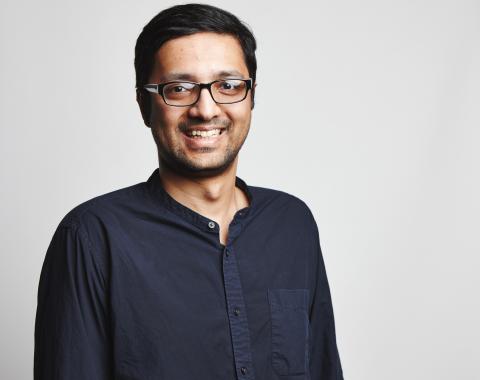Berklee's Rishabh Rajan Looks at the EDI Music Vanguard

Rishabh Rajan, electronic music producer and assistant professor in Berklee's Electronic Production and Design Department
Image courtesy of Rishabh Rajan
People have been making music with electronics since early last century, when pioneering music technologists plinked out primordial notes on the first synthesizers. Since then, electronically produced sounds have gradually filled more of our aural ether.
But over the past several years in particular the number and scope of electronic instruments have expanded music-making into new territory, allowing artists to make compositions of a kind never heard before.
Recognizing the musical potential these machines are breaking open, Berklee announced this week that it will allow students to study an electronic digital instrument (EDI)—a computing device with user-configured software and performance controllers—as a principal instrument starting next fall.
One of the people EDI principals will study with is Rishabh Rajan, a longtime electronic musician who has taught in India, Malaysia, and the United States; developed a robust series of video tutorials; published two books for Native Instruments; and produced under the name code:MONO.
Looking at the development of EDI-created music in recent years, Rajan, an assistant professor in Berklee’s Electronic Production and Design Department, talked about the artists he considers to be the vanguard of the field today. Here he tells us who they are and explains what they are doing differently.
Imogen Heap, "Me, the Machine"
"Imogen Heap has always been on the bleeding edge of music technology. Over the past few years she has simplified her performance setup to just her custom-created Mi.Mu gloves. In this video, Imogen Heap is using the gloves exclusively to perform the song 'Me, the Machine.' The gloves record her gestures, which are then transmitted to the custom software program Glover, which translates those gestures to MIDI and OSC (Open Sound Control) that can be musically interpreted by a digital audio workstation, namely Ableton Live. In the song, each little gesture from the glove is either triggering drum parts, loop recording, adding effects, muting and unmuting parts."
Shawn Wasabi, "Marble Soda"
"Shawn Wasabi is not only a masterful finger drummer, he is also phenomenal at creating mashups. In 'Marble Soda,' you hear a mashup of over 150 songs combined into one seamless original musical piece. The mashup is performed on a MIDI Fighter 64, which is a button controller used to trigger different sample snippets. The controller only has 64 buttons but Wasabi uses four buttons at the bottom to trigger banks that will switch all the samples on the remaining 60 buttons. So, potentially he has 60x4 possible locations for samples. The light patterns are used to add to the visual aesthetic but even that is specifically programmed for this performance."
Tennyson, "Uh Oh!"
"Tennyson is a brother-sister electronic music act from Canada. They are known for their highly complex musical arrangements that mix multiple genres and influences ranging from jazz to IDM (intelligent dance music). Tess Pretty, the drummer, uses an electronic drum kit that has over 20 different trigger points, but those don’t just trigger the exact same sample throughout the song. Behind the scenes there is an automated process that changes the sounds for each drum pad, introducing variability on each hit. Luke Tennyson, on the other hand, plays the keyboard parts but he also has a 4x4 grid of buttons to trigger various samples. Just like Pretty’s drum kit, his 4x4 grid is also automated to change the samples throughout the song. So, for example, triggering the same pad at the beginning of the song as compared to triggering it 16 bars in will produce a different sound."
Andrew Huang on the Microgranny + OP-1 Jam
"Andrew Huang is probably one of the most popular YouTube electronic music artists right now. He constantly redefines what an electronic musical instrument is in each of his videos, performing and manipulating sounds from his voice, vegetables, candy, Legos, household objects, and even human body parts! The great thing about each video is that Huang shows his entire compositional process and explains various elements of his performance. The viewer/listener leaves each video being entertained but also educated in the process of the making and performance of a musical track, which is typically not the case when experiencing artist performances or music videos. In this video, Huang is using two different synthesizers, the Microgranny—a sampler with some processing capabilities—and the OP-1, which is used to record the sounds from the Microgranny and add additional parts from its internal synths. At one point, Huang samples his own voice on the Microgranny and incorporates it into the performance."




